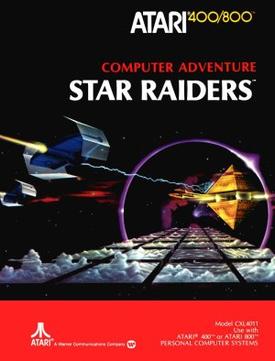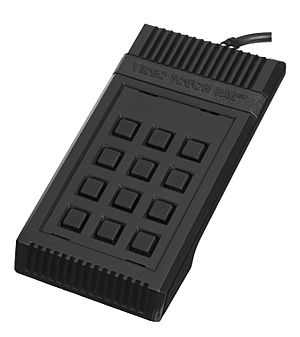Star Raiders facts for kids
Quick facts for kids Star Raiders |
|
|---|---|

Atari 8-bit cover art
|
|
| Developer(s) | Atari, Inc. Atari Corporation (ST) |
| Publisher(s) | Atari, Inc. Atari Corporation (ST) |
| Designer(s) | Doug Neubauer |
| Platform(s) | Atari 8-bit, Atari 2600, Atari 5200, Atari ST |
| Release date(s) | Atari 8-bit
|
| Genre(s) | Space combat simulator |
| Mode(s) | Single-player |
Star Raiders is a first-person space combat simulator for the Atari 8-bit family of computers. It was written by Doug Neubauer, an Atari employee, and released as a cartridge by Atari in 1979. The game is considered the platform's killer app. It was later ported to the Atari 2600, Atari 5200, and Atari ST.
The game simulates 3D space combat between the player's ship and an invading fleet of alien "Zylon" vessels. Star Raiders was distinctive for its graphics, which, in addition to various map and long range scan views, provided forward and aft first-person views, with movement conveyed by a streaming 3D starfield as the player engaged enemy spacecraft.
While there had already been target-shooting games using the first-person perspective (including 1978's Cosmic Conflict), Star Raiders had considerably higher quality visuals and more complex gameplay. It inspired imitators throughout the 1980s as well as later-generation space combat simulation games including Elite, Wing Commander, and Star Wars: X-Wing.
In 2007, Star Raiders was included in a list of the 10 most important video games of all time, as compiled by Stanford University's History of Science and Technology Collections.
Contents
Gameplay
Like the text-based Star Trek games, in Star Raiders the player's ship maneuvers about a two-dimensional grid fighting a fleet of enemy spaceships. In Star Raiders, this part of the game takes the form of a "Galactic Chart" display dividing the game's large-scale world into a grid of sectors, some of which are empty, while other are occupied by enemy ships or a friendly "starbase". The Galactic Map is the equivalent of the earlier Star Trek's Long Range Scan.
Flying about in the 3D view with the ship's normal engines is sufficient for travel within a sector; travel between sectors is via "hyperspace", accomplished through an elaborate and noisy "hyperwarp" sequence with graphics loosely reminiscent of the Star Wars and Star Trek films in which the stars seemed to stretch to radial lines. On the higher difficulty levels, hyperwarp has a skill element; the player has to keep a wandering cross hair roughly centered during the sequence in order to arrive precisely at the desired destination.
Combat, damage and resources
To the Star Trek formula, the game added real-time 3D battles as a space combat simulator. In the main first-person display, the player can look out of the ship and shoot "photons" at Zylon ships, which come in three different varieties reminiscent of ships from Star Wars, Star Trek, and Battlestar Galactica (whose villains were the similarly titled Cylons).
A small targeting display in the lower right corner gives a general indication of a distant enemy or starbase's position relative to the player's ship, and also indicates when weapons are locked on the enemy, at which point the player's weapons will fire two torpedoes simultaneously. There is also a "long-range scan" screen showing the surrounding region in a third-person overhead view centered on your ship, operating like a long-range radar display.
Enemy ships come in three types. The standard Fighters resemble the TIE fighter. The Patrol ships, which do not fire until fired upon, loosely resemble the front-on view of a Cylon Raider or Klingon Battlecruiser. The most powerful Zylon ship, the Basestar, has a pulsating orange glow and resembles a Cylon Basestar. It also has shields, which protect it from incoming fire, thus requiring the player to either hit it multiple times in rapid succession at close range or get it into a Target Lock, which results in two torpedoes being fired simultaneously and tracking the target until impact.
The game has four difficulty levels; on all but the lowest "Novice" level players must steer the ship into hyperspace and collisions with random meteoroids and enemy fire can cause damage to the player's ship. Such damage includes malfunctioning or nonfunctional shields, engines, weapons or information displays. Any collision when shields are down destroys the ship and ends the game. Running out of energy likewise ends the game.
The player has to manage finite energy reserves as well as damage to the ship; it can be repaired and restocked by rendezvous with a friendly starbase. The enemy can also destroy a starbase if allowed to surround its Galactic Chart sector for too long, so the starbases have to be defended. All this lends Star Raiders a degree of complexity and a sense of player immersion that was rare in action games of the era.
Scoring
In contrast to many games of the era, the player can actually win the game by destroying all enemy ships in the galaxy. However, there is no running score display; only upon winning, dying or quitting the game will the player receive a "rating", which is a quasi-military rank accompanied by a numerical class with particularly bad play earning a rank of "Garbage Scow Captain" or "Galactic Cook". The rating depends on a formula involving the game play level, energy and time used, star bases destroyed (both by player or the enemy), the number of enemies destroyed, and whether the player succeeded in destroying all enemies, was destroyed, or aborted (quit or ran out of energy) the mission. Some possible ratings reach from Rookie to Star Commander.
Ports
Versions of Star Raiders were created for the Atari 2600, Atari 5200, and Atari ST series of computers.
The Atari 5200 version was done by programmer Joe Copson and released in autumn 1982. This version is nearly identical to the computer version, but takes advantage of the 5200's analog joystick by allowing for variable speed turning, and puts all the game functions in the player's hand via the controller's 12-button keypad. Other changes are graphical improvements to the Sector Scan mode by displaying small images of enemy ships and objects instead of pinpoints, alterations to some of the text responses to be more specific to the game-ending action, and automatically switching to Forward View when Hyperspace is engaged.
The Atari 2600 version was programmed by Carla Meninsky and released in 1982. It suffers somewhat due to the 2600's weaker graphics and sound capabilities. It shipped with a special keypad controller, the Video Touch Pad, to take the place of the computer keyboard. Although the controller was designed to accept overlays for compatibility with multiple games, Star Raiders was the only game to utilize it. In this version the Zylons are renamed "Krylons".
The Atari ST version was designed and programmed by Robert Zdybel with graphics and animation by Jerome Domurat and released by Atari Corporation in 1986. It is a very different game in many ways, with more enemy ship types, different weapons, slower action, and a map featuring a triangular grid instead of a square one, which makes it much easier for the Zylon ships to surround starbases.
Legacy
Sequels
Star Raiders II (1986)
The Star Raiders II that was released in 1986 by Atari Corp. had no relationship to the original other than the name, and was, in fact, merely a rebranded game originally developed as a licensed tie-in for the movie The Last Starfighter.
Unreleased Star Raiders II
In 2015, Kevin Savetz, host of the ANTIC Podcast, was contacted by former Atari, Inc. programmer Aric Wilmunder. Wilmunder mentioned he had been part of a team working on 8-bit computer games and decided to make a sequel to Star Raiders.
This version of Star Raiders II is faithful to the original gameplay, but designed to make use of new 32 kB cartridges. The torpedoes were replaced with a laser-like weapon that can be aimed semi-independently of the ship's motion. The enemies are now 3D wireframe ships instead of 2D sprites. The gridded galactic map was replaced with a free-form version. In this rendition, the player's home planet is in the upper left of the map, and the enemy ships are ultimately attempting to attack it. A number of planets can also be attacked on the surface in a view based on the Star Wars arcade game, which was being developed down the hall from Wilmunder's office.
The main part of the game was complete by early 1984, but Atari was in disarray and undergoing a continual downsizing. Eventually, he was laid off, but kept the source code when he left. He later unsuccessfully tried to interest the new Atari Corporation in the project.
The game, in an untuned but functionally complete and playable state, was added to the Internet Archive along with basic documentation and Wilmunder's telling of the history of the game.
2011 remake
A re-imagining of Star Raiders, developed by Incinerator Studios and published by Atari SA, was released for the PlayStation 3, Xbox 360 and Microsoft Windows on May 11, 2011.
Clones and influenced games
Many games heavily inspired by Star Raiders appeared, such as Starmaster (Atari 2600), Space Spartans (Intellivision), Moonbeam Express (TI-99/4A), Codename MAT (ZX Spectrum and Amstrad CPC) and Star Luster (Famicom–Japan only). Neubauer's own Solaris, for the Atari 2600, is both similar and in some ways more sophisticated than his earlier game, despite the difference in technology between the two systems.
Star Raiders inspired later space combat games like Elite, the Wing Commander series and BattleSphere.
Star Rangers, an homage to Star Raiders, was released in 2010 for the iPhone. It was written by former 8-bit game programmer Tom Hudson, who was at one time a technical editor for Atari hobbyist magazine ANALOG Computing. As of October 2014, possibly earlier, Star Rangers is no longer in the iOS App Store.
Source code
A scan of the original assembly language source code became available in October 2015 via the Internet Archive. It was used to create a text-file version in GitHub.



